From supply chains to port congestion, infrastructure investments to remote work, it’s a new world out there
If you think back to this time in 2020, what’s happened over the past two years would only have made sense in a movie. Lockdowns, panic buying, empty streets, things were pretty grim and surreal. And when cargo finally arrived at ports and warehouses, it still had to be delivered. The trucking industry was hard hit, but at the same time people woke up to how essential it was and how fragile our global supply chain is.
But all these challenges brought new opportunities and much needed attention to the entire trucking industry. As 2022 begins, we can look back at the past two years as the kick in the pants we needed to make some real changes to how things get done.
The global pandemic threw a spotlight on weaknesses in our global supply chains, ushered in a new era of how and where work gets done, and got North America’s aging infrastructure the attention it deserves.
While 2020 could only be described as chaotic, and in 2021 things started to get to something more like normal, though not quite, there’s a lot to reflect on from the past two years and a lot to look forward to in this one.
Working from home is the new normal—and so is cloud-based software
For hundreds of years people have gone into offices for work. It was just how it was done. Anything else was just…wrong. Then in 2020 everyone was forced to figure out how working from home would work, and it turned out, a lot of people like it. Businesses saw productivity increase and employees found flexible work hours helped them manage their time better.
Overnight people learned how to use Zoom, Slack, and Teams. Google Drive, Dropbox, and OneDrive became the new shared drives. Everyone was working online, and hundreds of businesses realized they needed their critical software systems accessible from anywhere. If your TMS only worked when you were in your office, you needed to adapt or close up shop.
In the trucking and freight industries, this translated to companies switching to cloud-based, SaaS solutions for scheduling, invoicing, and dispatching. Having a TMS in the cloud went from a nice to have option to a competitive advantage. Putting your TMS in the cloud meant no one needed to be tied to a desk to run their businesses. Work from home (hello comfy slippers and sweats)? No problem. Land a new contract or book a load from the road—even right at the terminal? You got it.
Where working in the cloud was for hip tech startups a few years ago, now most businesses are wondering why did they ever do it any other way? No hassles with upgrades. No extra computers or servers needed. More getting work done and less getting IT to fix something before you can even start. In 2020 cloud-based TMS solutions were just catching on. In 2021 they became the new normal. In 2022, cloud-based software is going to push even farther into businesses giving small businesses the tools and agility to take on even the biggest competitors.
Ports and supply chains are still an issue
A hallmark of 2021 was the unending backlog at ports. In 2020 supply chains dried up, in 2021 they came roaring back, but there weren’t enough containers to transport goods and there weren’t enough truckers to carry the containers. New pandemic rules made it harder to get loads going and you can only get so many trucks into and out of a port.
The port congestion crisis hit hard in 2021, but looks like it will continue well into 2022. As new rules for greening ports—like the rolling ban on trucks older than 10 years at the Port of Vancouver—or vaccine mandates imposed on truckers; ports and supply chains will continue to feel the pressure.
In the U.S. and Canada, we are short tens of thousands of commercial truck drivers. Making the problems at ports even worse with over-worked and over-taxed drivers trying to play catch up. New dynamic routing and pick up solutions might well prove to be the way trucking companies can do more with less. If you can use technology to get the most out of all your drivers and still give them the time off they need to recharge, then you have an easy way to make the most out of the situation.
The port situation isn’t going to resolve any time soon, but getting smart about how loads are booked and planned, can start making a dent in things.
Aging infrastructure finally gets attention
After decades of neglect, roads, highways, and bridges are finally getting the attention they deserve. We detailed the $1.2 trillion infrastructure package in a previous post, but as work starts on repairing roads and bridges, the trucking industry will finally have better roads to travel and trains faster corridors to get goods across the continent.
These are long term projects. It will be five or more years before we see real changes to transport infrastructure, but there is one part of the bill that will have an immediate impact this year: driver training.
Focus on workforce development
A key part of the Infrastructure plan is helping get more people behind the wheel of trucks. The current driver shortage has been years, decades, in the making, and there will be no quick fixes. However with money set up for more training programs and changes to regulations to allow younger drivers work interstate routes, things are looking brighter.
This infographic outlines some of the challenges the industry faces to find and keep truckers:

Investing in technology is the new competitive advantage
2022 has started off with a reply of the beginning of the pandemic, but the end is in sight. For the trucking industry this will mean getting up, dusting off, and getting down to work. But the world has changed. How and where people get work done has changed. To meet this challenge and be successful in 2022 and beyond, trucking companies need to invest and update how they do things.
The same old way won’t attract new drivers, help you make the most out of the drivers you have, or build your business. All of these things from the past two years—working from home, port congestion, driver shortages—all have a similar solution: investing in newer technology takes the strain off your company. Older TMS systems, or the paper-pen-spreadsheet system don’t let you see opportunities. New technologies leverage AI and machine learning to find better routes, locate new opportunities, and let you get more work done with the same number of people.
Find out how Envase can help kick your business into high gear and make 2022 the beginning of something great for your business.




